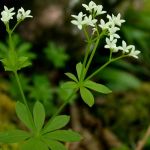| Common Name: |
Sweet Woodruff |
| Botanical Name: |
Galium odoratum syn. Asperula odorata |
| Genus: |
Galium |
| Family: |
Rubiaceae |
| Native Location: |
Europe, N Africa, Russia |
| Cultivation: |
Moist, well-drained, neutral to alkaline soil in shade. G. verum prefers drier, sunny conditions. |
| Propagation: |
By seed sown when ripe; by division in autumn or early spring. |
| Harvest: |
Plants are cut when flowering and dried for infusions, liquid extracts, and tablets. Galium aparine is usually used fresh, either juiced or in oil for external use. Seeds are collected when ripe. |
| Height: |
45cm (18in) |
| Width: |
Indefinite |
| Hardiness: |
Z3-9 |
| Parts Used: |
Whole plant |
| Properties: |
An astringent, slightly bitter herb, aromatic when dried, with tonic, diuretic, and sedative effects. It improves liver function, relaxes spasms, strengthens capillaries, and reduces blood clotting. |
| Medicinal Uses: |
Internally for thrombophlebitis, varicose veins, biliary obstruction, hepatitis, jaundice, and insomnia in children. Used in homeopathy for inflammation of the uterus. |
| Culinary Uses: |
Sprigs are soaked in white wine to make Maitrank or Maibowle (Alsace), and added to fruit cups. |
| Economic Uses: |
|
Dried herb is an ingredient of potpourris.
| Bibliography: |
Encyclopedia of Herbs by Deni Brown Copyright © 1995, 2001 Dorling Kindersley Limited. pg 219 |

